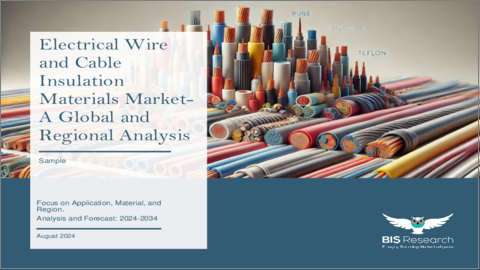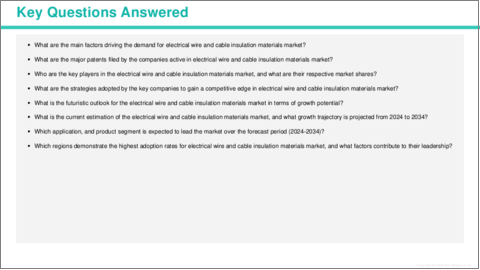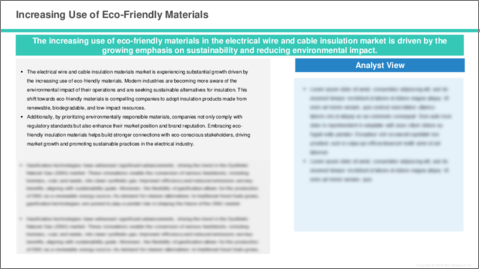|
|
市場調査レポート
商品コード
1551342
電線・ケーブル絶縁材料市場- 世界および地域別分析:用途別、材料別、地域別 - 分析と予測(2024年~2034年)Electrical Wire and Cable Insulation Materials Market - A Global and Regional Analysis: Focus on Application, Material, and Region - Analysis and Forecast, 2024-2034 |
||||||
カスタマイズ可能
|
|||||||
| 電線・ケーブル絶縁材料市場- 世界および地域別分析:用途別、材料別、地域別 - 分析と予測(2024年~2034年) |
|
出版日: 2024年09月10日
発行: BIS Research
ページ情報: 英文 110 Pages
納期: 1~5営業日
|
- 全表示
- 概要
- 目次
電線・ケーブル絶縁材料市場は、持続可能で高性能な絶縁ソリューションに対する需要の高まりに対応する重要なセクターとして急速に台頭しており、さまざまな世界市場で牽引力を増しています。
産業界がその選択による環境および安全への影響をより意識するようになるにつれ、先進的な絶縁材料は環境に優しく信頼性の高い代替手段を提供し、電気干渉や環境破壊に対する優れた保護を保証します。このシフトは、耐久性があり効率的な材料に対する意識の高まりと嗜好に加え、技術革新と規制遵守への欲求が後押ししています。楽観的シナリオでは、2024年に129億米ドルと評価された電線・ケーブル絶縁材料の市場規模は、CAGR 5.36%で成長し、2034年には217億5,000万米ドルに達すると予測されています。
環境の持続可能性に対する意識の高まりと環境に優しい製品に対する需要の増加が、業界における高度な電線・ケーブル絶縁材料へのニーズを促進しています。電気系統の故障や安全上の懸念が増加の一途をたどる中、有害物質を含まない効果的で安全な絶縁ソリューションの必要性が高まっています。安全性と効率に妥協することなく、耐久性があり高性能な代替品を提供する能力を持つ先進的な絶縁材料は、送電、通信、産業機械などの用途で重要なソリューションとして浮上しています。この市場は、再生可能エネルギー・プロジェクトへの注目の拡大や、持続可能で信頼性の高い電気システムを確保するための規制遵守の動向の高まりにより、著しい成長を遂げています。
| 主要市場統計 | |
|---|---|
| 予測期間 | 2024年~2034年 |
| 2024年評価 | 129億米ドル |
| 2034年予測 | 217億5,000万米ドル |
| CAGR | 5.36% |
電線・ケーブル用絶縁材料市場では、研究開発コストの高さや、持続可能で高性能な材料の調達に伴う複雑さが課題となっています。さらに、厳しい規制基準を遵守しながら製品の安全性と信頼性を確保することが、市場参入と拡大にさらなる複雑さをもたらしています。しかし、こうした課題は、メーカー、材料サプライヤー、規制機関の間で技術革新と協力を促進し、より高度な断熱ソリューションの開発を推進し、さまざまな産業への応用の可能性を広げています。この協力的な取り組みは、持続可能な実践の成長を支援し、電気システムの全体的な効率と安全性を高めます。
北米は、大規模なインフラ整備、技術の進歩、厳格な規制基準により、地域別電線・ケーブル絶縁材料市場をリードしています。米国とカナダでは、信頼性が高く効率的な送配電システムへの需要が高まっており、高品質の絶縁材料への投資に拍車がかかっています。同地域では送電網の近代化、再生可能エネルギープロジェクトの拡大、通信網の進歩が重視されており、同市場をさらに強化しています。さらに、米国はその高度なインフラと強固な産業基盤を活用して北米地域をリードしています。信頼性が高く効率的な送電に対する高い需要が、再生可能エネルギー・プロジェクトやスマートグリッド技術への多額の投資と相まって、市場を前進させています。米国はまた、安全性、耐久性、性能の強化に重点を置いており、断熱材の技術的進歩の最前線にあります。
当レポートでは、世界の電線・ケーブル絶縁材料市場について調査し、市場の概要とともに、用途別、材料別、地域別の動向、および市場に参入する企業のプロファイルなどを提供しています。
目次
エグゼクティブサマリー
第1章 市場:業界の展望
- 動向:現在および将来の影響評価
- サプライチェーンの概要
- R&Dレビュー
- 規制状況
- ステークホルダー分析
- 主要な世界的イベントの影響分析
- 市場力学の概要
第2章 電線・ケーブル絶縁材料市場(用途別)
- 用途のセグメンテーション
- 用途の概要
- 電線・ケーブル絶縁材料市場(用途別)
第3章 電線・ケーブル絶縁材料市場(製品別)
- 製品セグメンテーション
- 製品概要
- 電線・ケーブル絶縁材料市場(材料別)
第4章 電線・ケーブル絶縁材料市場(地域別)
- 電線・ケーブル絶縁材料市場(地域別)
- 北米
- 欧州
- アジア太平洋
- その他の地域
第5章 企業プロファイル
- 今後の見通し
- 地理的評価
- 企業プロファイル
- DuPont
- BASF SE
- Celanese Corporation
- Dow
- Covestro AG
- Solvay
- Arkema
- Eastman Chemical Company
- LG Chem
- Mitsubishi Chemical Corporation
- LyondellBasell Industries Holdings B.V.
- Evonik
- INEOS
- UBE Corporation
- Exxon Mobil Corporation
- その他の主要企業
第6章 調査手法
Introduction to Electrical Wire and Cable Insulation Materials Market
The electrical wire and cable insulation materials market is rapidly emerging as a vital sector addressing the growing demand for sustainable and high-performance insulation solutions, gaining traction across various global markets. As industries become more conscious of the environmental and safety implications of their choices, advanced insulation materials offer eco-friendly and reliable alternatives, ensuring superior protection against electrical interference and environmental damage. This shift is driven by increasing awareness and preference for durable and efficient materials, coupled with a desire for innovation and regulatory compliance. In an optimistic scenario, the market, valued at $12.90 billion in 2024, is anticipated to grow at a CAGR of 5.36%, reaching $21.75 billion by 2034.
The rising awareness of environmental sustainability and increasing demand for eco-friendly products are driving the need for advanced electrical wire and cable insulation materials in the industry. As incidences of electrical failures and safety concerns continue to rise, there is a growing necessity for effective and safe insulation solutions that are free from harmful substances. Advanced insulation materials, with their ability to provide durable, high-performance alternatives without compromising on safety and efficiency, have emerged as a vital solution across applications such as power transmission, telecommunications, and industrial machinery. This market is witnessing significant growth due to the expanding focus on renewable energy projects and the growing trend of regulatory compliance, ensuring sustainable and reliable electrical systems.
| KEY MARKET STATISTICS | |
|---|---|
| Forecast Period | 2024 - 2034 |
| 2024 Evaluation | $12.90 Billion |
| 2034 Forecast | $21.75 Billion |
| CAGR | 5.36% |
In the electrical wire and cable insulation materials market, challenges include high research and development costs and the complexities associated with sourcing sustainable and high-performance materials. Additionally, ensuring product safety and reliability while adhering to stringent regulatory standards adds further complexity to market entry and expansion. However, these challenges promote innovation and collaboration among manufacturers, material suppliers, and regulatory bodies, driving the development of more advanced insulation solutions and expanding their potential applications across various industries. This collaborative effort supports the growth of sustainable practices and enhances the overall efficiency and safety of electrical systems.
North America is leading the Electrical Wire and Cable Insulation Materials Market by region, driven by significant infrastructure development, technological advancements, and stringent regulatory standards. The growing demand for reliable and efficient power transmission and distribution systems in the US and Canada has spurred investments in high-quality insulation materials. The region's emphasis on modernization of the electrical grid, expansion of renewable energy projects, and advancements in telecommunication networks further strengthens this market. Additionally, U.S. leads the North America region, utilizing its advanced infrastructure and robust industrial base. High demand for reliable and efficient power transmission, coupled with significant investments in renewable energy projects and smart grid technologies, propels the market forward. U.S. is also at the forefront of technological advancements in insulation materials, driven by a strong focus on enhancing safety, durability, and performance.
Key players such as DuPont, BASF SE, Celanese Corporation, and Dow are at the forefront of market expansion, utilizing their technological expertise and strategic partnerships to drive innovation and capture a significant market share. Companies are investing in the construction of new production facilities and the expansion of existing ones to meet the growing demand. For instance in May 2022, Krempel announced its exclusive production and sale of Nomex 910, an eco-friendly insulating material developed by DuPont. Made from high-quality electrical grade cellulose pulp, Nomex 910 aligns with the growing trend towards sustainable materials in the electrical insulation market. This partnership strengthens Krempel's market position while promoting environmental responsibility and innovation.
Market Segmentation:
Segmentation 1: by Application
- Electrical Wire
- Electrical Cable
Segmentation 2: by Material
- Plastic Insulation
- Polyvinyl Chloride (PVC)
- Semi-Rigid PVC (SR-PVC)
- Plenum Polyvinyl Chloride (Plenum PVC)
- Polyethylene (PE)
- Polypropylene (PP)
- Polyurethane (PUR)
- Nylon Insulation
- Modified Polyphenylene Ether (MPPE)
- Others
- Rubber Insulation
- Thermoplastic Rubber (TPR)
- Neoprene (Polychloroprene)
- Styrene-Butadiene Rubber (SBR)
- Silicone Rubbers
- Fiberglass
- Ethylene Propylene Rubber (EPR)
- Chlorosulfonated Polyethylene (CSPE)
- Ethylene Propylene Diene Monomer (EPDM)
- Others
- Fluoropolymer Insulation
- Perfluoroalkoxy (PFA)
- Polytetrafluoroethylene (PTFE)
- Fluorinated Ethylene Propylene (FEP)
- Ethylene Tetrafluoroethylene (ETFE) and Ethylenechlorotrifluoroethylene (ECTFE) Halar
- Polyvinylidene Fluoride (PVDF)
- Thermoplastic Elastomers (TPE)
- Others
Segmentation 3: by Region
- North America
- Europe
- Asia-Pacific
- Rest-of-the-World
How can this report add value to an organization?
Product/Innovation Strategy: The global electrical wire and cable insulation materials market has been extensively segmented based on various categories, such as application, material, and region. This can help readers get a clear overview of which segments account for the largest share and which ones are well-positioned to grow in the coming years.
Competitive Strategy: A detailed competitive benchmarking of the players operating in the global electrical wire and cable insulation materials market has been done to help the reader understand how players stack against each other, presenting a clear market landscape. Additionally, comprehensive competitive strategies such as partnerships, agreements, and collaborations will aid the reader in understanding the untapped revenue pockets in the market.
Key Market Players and Competition Synopsis
The companies that are profiled have been selected based on thorough secondary research, which includes analyzing company coverage, product portfolio, market penetration, and insights gathered from primary experts.
Some of the prominent companies in this market are:
- DuPont
- BASF SE
- Celanese Corporation
Key Questions Answered in this Report:
- What are the main factors driving the demand for electrical wire and cable insulation materials market?
- What are the major patents filed by the companies active in electrical wire and cable insulation materials market?
- Who are the key players in the electrical wire and cable insulation materials market, and what are their respective market shares?
- What are the strategies adopted by the key companies to gain a competitive edge in electrical wire and cable insulation materials market?
- What is the futuristic outlook for the electrical wire and cable insulation materials market in terms of growth potential?
- What is the current estimation of the electrical wire and cable insulation materials market, and what growth trajectory is projected from 2024 to 2034?
- Which application, and product segment is expected to lead the market over the forecast period (2024-2034)?
- Which regions demonstrate the highest adoption rates for electrical wire and cable insulation materials market, and what factors contribute to their leadership?
Table of Contents
Executive Summary
Scope and Definition
Market/Product Definition
Key Questions Answered
Analysis and Forecast Note
1. Markets: Industry Outlook
- 1.1 Trends: Current and Future Impact Assessment
- 1.1.1 Increasing Use of Eco-Friendly Materials
- 1.1.2 Expansion of Electric Vehicle Infrastructure Requiring Specialized Insulation
- 1.2 Supply Chain Overview
- 1.2.1 Value Chain Analysis
- 1.2.2 Pricing Forecast
- 1.3 R&D Review
- 1.3.1 Patent Filing Trend by Country, by Company
- 1.4 Regulatory Landscape
- 1.5 Stakeholder Analysis
- 1.5.1 Use Case
- 1.5.2 End User and Buying Criteria
- 1.6 Impact Analysis for Key Global Events
- 1.7 Market Dynamics Overview
- 1.7.1 Market Drivers
- 1.7.2 Market Restraints
- 1.7.3 Market Opportunities
2. Electrical Wire and Cable Insulation Materials Market (by Application)
- 2.1 Application Segmentation
- 2.2 Application Summary
- 2.3 Electrical Wire and Cable Insulation Materials Market (by Application)
- 2.3.1 Electrical Wire
- 2.3.2 Electrical Cable
3. Electrical Wire and Cable Insulation Materials Market (by Product)
- 3.1 Product Segmentation
- 3.2 Product Summary
- 3.3 Electrical Wire and Cable Insulation Materials Market (by Material)
- 3.3.1 Plastic Insulation
- 3.3.1.1 Polyvinyl Chloride (PVC)
- 3.3.1.2 Semi-Rigid PVC (SR-PVC)
- 3.3.1.3 Plenum Polyvinyl Chloride (Plenum PVC)
- 3.3.1.4 Polyethylene (PE)
- 3.3.1.5 Polypropylene (PP)
- 3.3.1.6 Polyurethane (PUR)
- 3.3.1.7 Nylon Insulation
- 3.3.1.8 Modified Polyphenylene Ether (MPPE)
- 3.3.1.9 Others
- 3.3.2 Rubber Insulation
- 3.3.2.1 Thermoplastic Rubber (TPR)
- 3.3.2.2 Neoprene (Polychloroprene)
- 3.3.2.3 Styrene-Butadiene Rubber (SBR)
- 3.3.2.4 Silicone Rubbers
- 3.3.2.5 Fiberglass
- 3.3.2.6 Ethylene Propylene Rubber (EPR)
- 3.3.2.7 Chlorosulfonated Polyethylene (CSPE)
- 3.3.2.8 Ethylene Propylene Diene Monomer (EPDM)
- 3.3.2.9 Others
- 3.3.3 Fluoropolymer Insulation
- 3.3.3.1 Perfluoroalkoxy (PFA)
- 3.3.3.2 Polytetrafluoroethylene (PTFE)
- 3.3.3.3 Fluorinated Ethylene Propylene (FEP)
- 3.3.3.4 Ethylene Tetrafluoroethylene (ETFE) and Ethylenechlorotrifluoroethylene (ECTFE) Halar
- 3.3.3.5 Polyvinylidene Fluoride (PVDF)
- 3.3.3.6 Thermoplastic Elastomers (TPE)
- 3.3.3.7 Others
- 3.3.1 Plastic Insulation
4. Electrical Wire and Cable Insulation Materials Market (by Region)
- 4.1 Electrical Wire and Cable Insulation Materials Market (by Region)
- 4.2 North America
- 4.2.1 Regional Overview
- 4.2.2 Driving Factors for Market Growth
- 4.2.3 Factors Challenging the Market
- 4.2.4 Application
- 4.2.5 Product
- 4.2.6 Electrical Wire and Cable Insulation Materials Market (by Country)
- 4.2.6.1 U.S.
- 4.2.6.1.1 Market by Application
- 4.2.6.1.2 Market by Product
- 4.2.6.2 Canada
- 4.2.6.2.1 Market by Application
- 4.2.6.2.2 Market by Product
- 4.2.6.3 Mexico
- 4.2.6.3.1 Market by Application
- 4.2.6.3.2 Market by Product
- 4.2.6.1 U.S.
- 4.3 Europe
- 4.3.1 Regional Overview
- 4.3.2 Driving Factors for Market Growth
- 4.3.3 Factors Challenging the Market
- 4.3.4 Application
- 4.3.5 Product
- 4.3.6 Electrical Wire and Cable Insulation Materials Market (by Country)
- 4.3.6.1 Germany
- 4.3.6.1.1 Market by Application
- 4.3.6.1.2 Market by Product
- 4.3.6.2 France
- 4.3.6.2.1 Market by Application
- 4.3.6.2.2 Market by Product
- 4.3.6.3 U.K.
- 4.3.6.3.1 Market by Application
- 4.3.6.3.2 Market by Product
- 4.3.6.4 Italy
- 4.3.6.4.1 Market by Application
- 4.3.6.4.2 Market by Product
- 4.3.6.5 Rest-of-Europe
- 4.3.6.5.1 Market by Application
- 4.3.6.5.2 Market by Product
- 4.3.6.1 Germany
- 4.4 Asia-Pacific
- 4.4.1 Regional Overview
- 4.4.2 Driving Factors for Market Growth
- 4.4.3 Factors Challenging the Market
- 4.4.4 Application
- 4.4.5 Product
- 4.4.6 Electrical Wire and Cable Insulation Materials Market (by Country)
- 4.4.6.1 China
- 4.4.6.1.1 Market by Application
- 4.4.6.1.2 Market by Product
- 4.4.6.2 Japan
- 4.4.6.2.1 Market by Application
- 4.4.6.2.2 Market by Product
- 4.4.6.3 India
- 4.4.6.3.1 Market by Application
- 4.4.6.3.2 Market by Product
- 4.4.6.4 South Korea
- 4.4.6.4.1 Market by Application
- 4.4.6.4.2 Market by Product
- 4.4.6.5 Rest-of-Asia-Pacific
- 4.4.6.5.1 Market by Application
- 4.4.6.5.2 Market by Product
- 4.4.6.1 China
- 4.5 Rest-of-the-World
- 4.5.1 Regional Overview
- 4.5.2 Driving Factors for Market Growth
- 4.5.3 Factors Challenging the Market
- 4.5.4 Application
- 4.5.5 Product
- 4.5.6 Rest-of-the-World Electrical Wire and Cable Insulation Materials Market (by Region)
- 4.5.6.1 South America
- 4.5.6.1.1 Market by Application
- 4.5.6.1.2 Market by Product
- 4.5.6.2 Middle East and Africa
- 4.5.6.2.1 Market by Application
- 4.5.6.2.2 Market by Product
- 4.5.6.1 South America
5. Companies Profiled
- 5.1 Next Frontiers
- 5.2 Geographic Assessment
- 5.3 Company Profiles
- 5.3.1 DuPont
- 5.3.1.1 Overview
- 5.3.1.2 Top Products/Product Portfolio
- 5.3.1.3 Top Competitors
- 5.3.1.4 Target Customers
- 5.3.1.5 Key Personnel
- 5.3.1.6 Analyst View
- 5.3.1.7 Market Share
- 5.3.2 BASF SE
- 5.3.2.1 Overview
- 5.3.2.2 Top Products/Product Portfolio
- 5.3.2.3 Top Competitors
- 5.3.2.4 Target Customers
- 5.3.2.5 Key Personnel
- 5.3.2.6 Analyst View
- 5.3.2.7 Market Share
- 5.3.3 Celanese Corporation
- 5.3.3.1 Overview
- 5.3.3.2 Top Products/Product Portfolio
- 5.3.3.3 Top Competitors
- 5.3.3.4 Target Customers
- 5.3.3.5 Key Personnel
- 5.3.3.6 Analyst View
- 5.3.3.7 Market Share
- 5.3.4 Dow
- 5.3.4.1 Overview
- 5.3.4.2 Top Products/Product Portfolio
- 5.3.4.3 Top Competitors
- 5.3.4.4 Target Customers
- 5.3.4.5 Key Personnel
- 5.3.4.6 Analyst View
- 5.3.4.7 Market Share
- 5.3.5 Covestro AG
- 5.3.5.1 Overview
- 5.3.5.2 Top Products/Product Portfolio
- 5.3.5.3 Top Competitors
- 5.3.5.4 Target Customers
- 5.3.5.5 Key Personnel
- 5.3.5.6 Analyst View
- 5.3.5.7 Market Share
- 5.3.6 Solvay
- 5.3.6.1 Overview
- 5.3.6.2 Top Products/Product Portfolio
- 5.3.6.3 Top Competitors
- 5.3.6.4 Target Customers
- 5.3.6.5 Key Personnel
- 5.3.6.6 Analyst View
- 5.3.6.7 Market Share
- 5.3.7 Arkema
- 5.3.7.1 Overview
- 5.3.7.2 Top Products/Product Portfolio
- 5.3.7.3 Top Competitors
- 5.3.7.4 Target Customers
- 5.3.7.5 Key Personnel
- 5.3.7.6 Analyst View
- 5.3.7.7 Market Share
- 5.3.8 Eastman Chemical Company
- 5.3.8.1 Overview
- 5.3.8.2 Top Products/Product Portfolio
- 5.3.8.3 Top Competitors
- 5.3.8.4 Target Customers
- 5.3.8.5 Key Personnel
- 5.3.8.6 Analyst View
- 5.3.8.7 Market Share
- 5.3.9 LG Chem
- 5.3.9.1 Overview
- 5.3.9.2 Top Products/Product Portfolio
- 5.3.9.3 Top Competitors
- 5.3.9.4 Target Customers
- 5.3.9.5 Key Personnel
- 5.3.9.6 Analyst View
- 5.3.9.7 Market Share
- 5.3.10 Mitsubishi Chemical Corporation
- 5.3.10.1 Overview
- 5.3.10.2 Top Products/Product Portfolio
- 5.3.10.3 Top Competitors
- 5.3.10.4 Target Customers
- 5.3.10.5 Key Personnel
- 5.3.10.6 Analyst View
- 5.3.10.7 Market Share
- 5.3.11 LyondellBasell Industries Holdings B.V.
- 5.3.11.1 Overview
- 5.3.11.2 Top Products/Product Portfolio
- 5.3.11.3 Top Competitors
- 5.3.11.4 Target Customers
- 5.3.11.5 Key Personnel
- 5.3.11.6 Analyst View
- 5.3.11.7 Market Share
- 5.3.12 Evonik
- 5.3.12.1 Overview
- 5.3.12.2 Top Products/Product Portfolio
- 5.3.12.3 Top Competitors
- 5.3.12.4 Target Customers
- 5.3.12.5 Key Personnel
- 5.3.12.6 Analyst View
- 5.3.12.7 Market Share
- 5.3.13 INEOS
- 5.3.13.1 Overview
- 5.3.13.2 Top Products/Product Portfolio
- 5.3.13.3 Top Competitors
- 5.3.13.4 Target Customers
- 5.3.13.5 Key Personnel
- 5.3.13.6 Analyst View
- 5.3.13.7 Market Share
- 5.3.14 UBE Corporation
- 5.3.14.1 Overview
- 5.3.14.2 Top Products/Product Portfolio
- 5.3.14.3 Top Competitors
- 5.3.14.4 Target Customers
- 5.3.14.5 Key Personnel
- 5.3.14.6 Analyst View
- 5.3.14.7 Market Share
- 5.3.15 Exxon Mobil Corporation
- 5.3.15.1 Overview
- 5.3.15.2 Top Products/Product Portfolio
- 5.3.15.3 Top Competitors
- 5.3.15.4 Target Customers
- 5.3.15.5 Key Personnel
- 5.3.15.6 Analyst View
- 5.3.15.7 Market Share
- 5.3.16 Other Key Companies
- 5.3.1 DuPont






